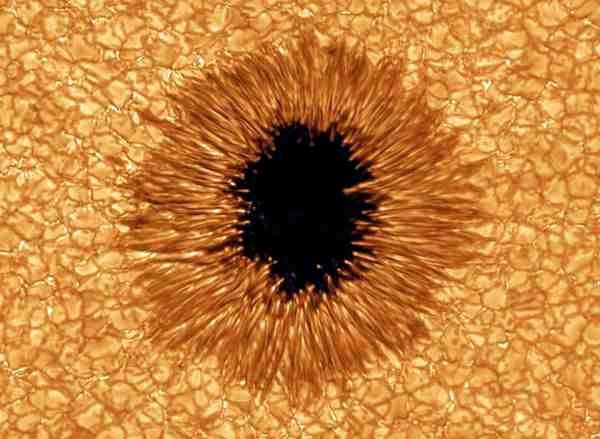On Wednesday 10 September 2014 at about 5.45 pm GMT, NASA's Solar Dynamics Observatory witnessed a sunspot labeled AR 2158 (Active Region 2158), which is currently facing towards the Earth, produce one of the largest Solar Flares so far this year. This has been classed as an X1.6-class flare (flare emitting more than 0.001 W/m² over more than 0.01% of the Earth's surface), potentially large enough to cause disruption to communications networks and electricity supplies on Earth. The flare caused the release of a coronal mass ejection (stream of plasma) that is traveling towards us at 1100 km per second, and will reach the Earth on Friday 12 September. This is likely to produce some spectacular auroras in the polar regions, and possibly at lower latitudes, but not to cause any serious harm.
An X1.6 solar flare flashes in the middle of the sun on 10 September 2014. NASA/Solar Dynamic Observatory.
Sunspots are magnetic storms on the face of the Sun. These inhibit convection currents in the Sun's photosphere, causing localized cooling; the surface of the Sun can drop from its usual 5778 K to as low as 3000 K in a Sunspot, causing them to darken compared to the rest of the Sun (though they are in fact still pretty bright). Since Sunspots are magnetic they have magnetic poles, with positive and negative charges. These can be connected by coronal loops, streams of magnetic flux carrying plasma above the surface of the Sun. This can lead to a short circuit in which a large amount of magnetic energy is released suddenly, producing a brightening we perceive as a Solar Flare.
Image of a sunspot captured by the New Solar Telescope in 2010. Big Bear Solar Observatory/New Jersey Institute of Technology.
This in turn can lead to the release of a coronal mass ejection, a stream of charged particles, mainly electrons and protons but with some ionized atoms of heavier elements such as helium or oxygen. This travels out from the Sun, typically taking about two days to reach the Earth's orbit.
When these streams of charged particles reach the Earth they can cause magnetic storms. These are usually harmless, with the energy being released in spectacular displays of light near the Earth's poles known as the Aurora Borealis (north) and Aurora Australis (south), but occasionally large events cause problems for electrical systems on Earth, such as the March 1989 event that knocked out electrical distribution networks in Quebec (such distribution networks are now generally better safeguarded against these events).
A coronal mass ejection imaged on 31 August 2012. NASA/STEREO-B/Goddard Space Flight Center.
Aurora displays come in a variety of colours, caused by electrons from the coronal mass ejection striking different atoms in the Earth's atmosphere. This is because the energy of the atoms increases each time it is struck by an electron, but atoms can only absorb so much energy before they must release some, and each atom always releases energy as light (photons) at a specific wavelengths. In the Earth's atmosphere this is effected by altitude, thus Oxygen releases either green or red light and Nitrogen releases either blue or violet light. Typically auroras shimmer as different reactions occur, photographs do not really do them justice.
An Aurora Borealis display over Chena Lake, Alaska in September 2009. Bud Kuenzli.
Gasses release light at specific wavelengths in response to other stimuli besides coronal mass ejections. Thus the blue colour of the daytime sky is the colour of Nitrogen in the lower atmosphere reacting to the (steady) energy input from sunlight, whereas the red colour of sunrises and sunsets is the colour of oxygen higher in the atmosphere reacting to the same; we see this at dawn and dusk because the sun is no longer in line of sight with the lower atmosphere. Neon lights are red because Neon gas releases red light in response to electrical charge, and Sodium lights orange for the same reason. Molecules made up of more than one sort of atom, such as Carbon Dioxide (CO₂), Water (H₂O) or Methane (CH₄) release light in the infra-red part of the spectrum, which can lead to warming of the atmosphere (the Greenhouse Effect), hence the current concerns about the release of such gasses into the atmosphere by industrial processes, and the effect this might have on our climate.
See also...
On Thursday 12 July 2012 at 4.52 pm GMT, NASA's Solar Dynamics Observatory witnessed a sunspot labeled AR 1520 (Active Region 1520), currently facing towards the Earth, produce one of the largest Solar Flares so far this year. This has been classed as an X1.4-class flare, potentially large enough to cause disruption to communications networks and electricity supplies on Earth, though...
At midnight on Tuesday 6/Wednesday 7 March 2012, GMT, the Sun emitted the largest solar flare since 9 August 2011; the second largest since its current last solar minimum in 2007 (solar activity increases and drops in an eleven years cycle). The flare was classified as an...
At about 4.00 am GMT on Monday 23 January 2012 a massive solar flare was observed on the sun, pointing more-or-less directly our way. An hour later radiation from the flare, a stream electrons, followed by a wave of protons (hydrogen ions) moving at 41.6...
Follow Sciency Thoughts on Facebook.







